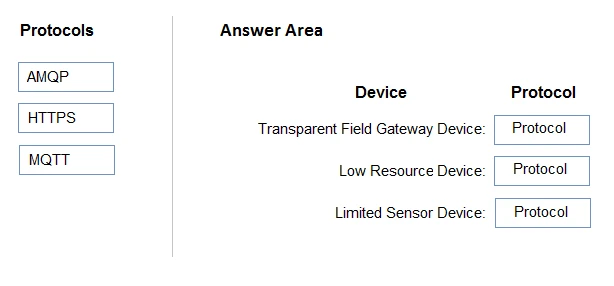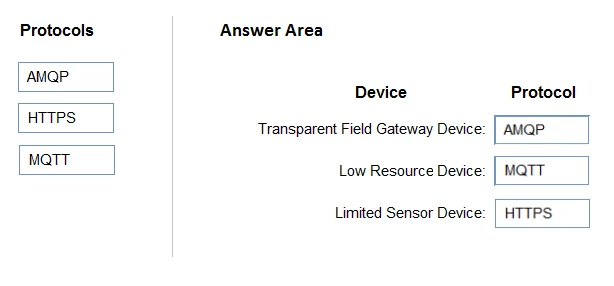You deploy an Azure IoT hub that is accessible at ContosoHub.azure-devices.net.
You need to ensure that Sensors.csv is uploaded to the IoT hub.
Which two actions should you perform? Each correct answer presents part of the solution.
NOTE: Each correct selection is worth one point.
In order to upload a CSV file to an Azure IoT hub, you need to perform two key actions. First, by using the IoT Hub's File Upload feature, you must configure the IoT hub to associate with a storage container. This is achieved by selecting the IoT hub in the Azure subscription, navigating to the File Upload section, and configuring an Azure Storage container to handle the uploaded files. Second, you need to utilize the IoT Hub REST API to upload the file. The IoT device sends a POST request to the IoT hub to request a SAS URI for uploading the file, enabling the IoT hub to manage and process these uploads.
The IoT hub must support the following:
✑ Three Azure IoT Edge devices
✑ 2,500 IoT devices
Each IoT device will spend a 6 KB message every five seconds.
You need to size the IoT hub to support the devices. The solution must minimize costs.
What should you choose?
To determine the appropriate IoT hub tier, we need to calculate the total data being sent by all IoT devices per minute and compare it with the tier capacities. Each device sends a 6 KB message every five seconds, which translates to 12 messages per minute (since there are 60 seconds in a minute). Therefore, each device sends 6 KB * 12 messages = 72 KB per minute. With 2,500 devices, the total data per minute would be 72 KB * 2,500 = 180,000 KB per minute, which is equivalent to 180 MB per minute. Considering the edge device requirement and the message flow, the S3 tier is the only one that can handle this load, as it supports up to 814 MB per minute. Thus, the S3 tier is the correct and cost-effective choice to meet the requirements of supporting 2,500 IoT devices and minimizing costs.
You deploy an Azure IoT hub.
You need to demonstrate that the IoT hub can receive messages from a device.
Which three actions should you perform in sequence? To answer, move the appropriate actions from the list of actions to the answer area and arrange them in the correct order.
Select and Place:

Before you can use your IoT devices with Azure IoT Edge, you must register them with your IoT hub. Once a device is registered, you can retrieve a connection string to set up your device for IoT Edge workloads.
Step 2: Configure the device connection string on a device client.
When you're ready to set up your device, you need the connection string that links your physical device with its identity in the IoT hub.
Step 3: Trigger a new send event from a device client.
Reference:
https://docs.microsoft.com/en-us/azure/iot-edge/how-to-register-device

You have an Azure IoT hub.
You plan to attach three types of IoT devices as shown in the following table.

You need to select the appropriate communication protocol for each device.
What should you select? To answer, drag the appropriate protocols to the correct devices. Each protocol may be used once, more than once, or not at all. You may need to drag the split bar between panes or scroll to view content.
NOTE: Each correct selection is worth one point.
Select and Place:

Use AMQP on field and cloud gateways to take advantage of connection multiplexing across devices.
Box 2: MQTT -
MQTT is used on all devices that do not require to connect multiple devices (each with its own per-device credentials) over the same TLS connection.
Box 3: HTTPS -
Use HTTPS for devices that cannot support other protocols.
Reference:
https://docs.microsoft.com/en-us/azure/iot-hub/iot-hub-devguide-protocols

What does MylotHub support?
The Azure IoT hub created with the command `az iot hub create --resource-group MyResourceGroup --name MyIotHub --sku B1 --location westus --partition-count 4` is created with the B1 SKU, which belongs to the Basic tier. The Basic tier of Azure IoT Hub does indeed support Azure IoT Edge. The other features mentioned, such as Device Provisioning Service, cloud-to-device messaging, and device twins, require the Standard tier. Therefore, Azure IoT Edge is the feature supported by the MyIotHub created with the specified command in the Basic tier.